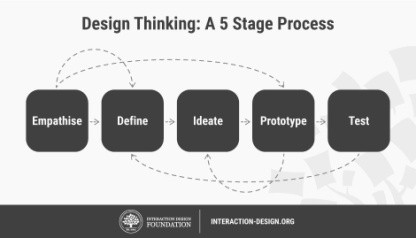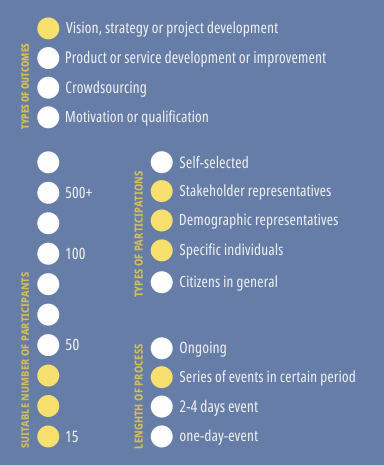-
Participatory methods
DESIGN THINKING – PROJECT IN A DAY
DESCRIPTION
Design Thinking (DT) is a design methodology that provides a solution-based approach to solving problems. It is extremely useful in tackling complex problems that are ill-defined or unknown, by understanding the human needs involved, by re-framing the problem in human-centric ways. This is prosecuted by stimulating the creation of innovative ideas in brainstorming sessions and by adopting a hands-on approach in prototyping and testing through the five stage of Design Thinking. It is a general approach, that could be applied to many occasions and will empower anyone to apply the Design Thinking methods in order to solve complex problems that occur around us — in companies, public administration, urban scenarios.
The five stages of Design Thinking are:
- Empathizing: Understanding the human needs involved.
- Defining: Re-framing and defining the problem in human-centric ways.
- Ideating: Creating many ideas in ideation sessions.
- Prototyping: Adopting a hands-on approach in prototyping.
- Testing: Developing a prototype/solution to the problem

This methodology is very useful to figuring out, how to make information available, more clear and understandable for all participants. The aim is to stimulate the unlock forms of value, not available clearly at the beginning of the process and to help in create a sort of “multiplier effects. Hence, we also need to design processes that allow us to spot new patterns, encourage the evolution of new ideas, and help new ideas scale to the point where they have impact.
This method is very interesting when we are looking for “rapid prototyping” and “learning by making” as a strategy for doing effective innovation.
This method is also very appropriate as a participatory method, because the complexity of the interactions cannot possibly be anticipated by even the smartest of plans, is it is important to make plan and test them in participatory ways, letting others participate in our innovation activities.
FOR WHO ?
It is important to understand the participant’s culture and habits that could be dramatically different from a typical startup/biz environment. So the process has to be adapted in accordance to the audience and if possible.
The participants of the DT should be selected and invited as accurately and selected as possible (possibility in doing this depend from the context), composing an overall classroom of about 25-40 persons, with the required heterogeneity between creativity, stakeholders, field experts, and presentation skills.
RESOURCES
Beside to the expert facilitator and to some assistant to the facilitator (1 each 2 groups, in order to be supportive) it is necessary to have a enough flexible large room available:
- Table and chairs, not fixed
- Several large (A0) sheet of white paper (a block)
- 1 Whiteboard for the facilitator
- As much as possible blocks of Post-it of several colors, color markers (big top)
- ActionCam/HiFi-Cam to acquire groups activity (and enable participants dynamics analysis offline)
- Double check if it is possible to attach to the wall room surface posters and printed materials (with ribbon).
PREPARATION OF THE PROCESS
It is fundamental to prepare and plan the design thinking lab in order to make the process smooth and effective.
FACILITATOR
The role of the facilitator is key here and it is not very easy to have one enough skilled. The facilitator needs to be dedicated to driving, facilitating and delivering high quality materials inside the Design Thinking sessions/labs and he has to be able to work through the entire design process using methods like sketching, storyboarding, diagramming, prototyping, and testing. Typically, he has also the ability to channel the talent of the participants, even when the participants are not so empathic or experienced with similar methodology. It should be someone that is able to help people break the ice and be comfortable.
PURPOSE
It is important to define a purpose of the design thinking participatory lab. Should be challenging but also feasible in a 2-3 months effort in a way that could land to something practical. The DT process is a creative process. It could be that something completely new appears during the process. The process ongoing could elaborate new inputs as well as the starting one, and with the help of the participants decide if the original purpose is still valid or must be refined or re-targeted.
DEFINE TIMELINE AND LOGISTICS
The design thinking could be implemented through laboratories that involve directly participants. 25-40 participants per laboratory is a good number that enable, one single expert facilitator to manage the participants in groups of 4-5 persons. This method should not be seen as an inflexible approach to create innovation. The five stages serve as a guide to the activities.
In order to gain the better and most informative insights for your particular project, these stages might be switched, conducted concurrently and repeated several times in order to expand the solution space, and narrow down on the best possible solutions. The overall time is from 1 month to several month, and could be repeated after a while.
The timeline is typically of some months, in order to separate the different phases with a couple of weeks at least. The mandatory phases in an urban innovation scenario are the first 3, so it could be a time line of 2-3 months.
Then must be planned the phase 4 and 5 that are related to the test, evaluation and implementation and could have a different time line in relation with the complexity of the problem faced.
Logistic is quite simple, a DT Lab does not requires technology and neither specific spaces. It enough a large room with several tables (+ chairs) not fixed. Then paper + pens + post is the only material requires.
SUPPORT DOCUMENTATION
All the possible information about the context focused by the DT lab should be collected from the stakeholders. Strategic planning document, official statement, previous elaboration and participatory campaign, everything could be useful to collect hints and keyword to be used on the DT lab table as creative input.
It could be the case, if possible (it requires additional time and effort) could be the case to run a preliminary step (e.g. a general public call for ideas that could collect some evidence about the explicit need of the civil society, association and citizens. The information available could then be elaborated and used in the DT labs.
Printed materials are useful, so make document available in digital folder (e.g. Google Drive, DropBox) but the most relevant, the urban planning, the spaces available, other elements could be printed before on recycled paper and used as input to the table.
INVITITATION OF PARTICIPANTS
It is important to understand the participants culture and habits, that could be dramatically different from a typical startup/biz environment. So the process has to be adapted in accordance to the audience. The aim of the DT lab is not to involve all the citizens and/or all the local association, but is to elaborate innovative solutions for specific problems. So it is important to define with accuracy the participants to the lab, maybe splitting it in more round, but in general it is a process that involve not more than 40-50 persons, from begin to end.
The lab is not strictly closed, so everyone could propose participants to the lab, and in general they are welcomed always, even if the process is already in phase 2 or 3.
Participants need to be invited in the first event and then must be kept in the loop for the entire process. Number of abandon or new comers it is a nice KPI of the effectiveness of the participatory process
ENVIRONMENT SET-UP
The atmosphere should be good and participant comfortable in order to break the ice easily.
The walls of the room could be used to attach several materials elaborated in the preparation phase that could help to contextualize the process. Good example, in the case of Urban Innovation process, could be pictures of the urban area focused, early rendered concepts, list of ideas as well cloud of keywords related to the context.
Try to gently accommodate persons and make easy for them to know each other, for example making them walking around, for a coffee or with any usable artifact of this kind.
IMPLEMENTATION OF THE PROCESS
The process is constituted in five stages:
Empathize: develop knowledge about what your users do, say, think, and feel, through direct observation of what they do, how they think, and what they want. Typical questions are like ‘what motivates or discourages users?’ or ‘where do they experience frustration?’ The objective of this phase is to gather enough observations that you can begin to empathize with your users and their perspectives.
Define: Combine all your research and observation to map where your users’ problems exist, drawing more clearly the users’ needs, highlighting opportunities for innovation. In order to do this, it is suggested to organize all observations and draw across your users’ current experiences, trying to find if there is a common hurting point across many different users? Did we find the unmet users needs?
Ideate: freely discuss and brainstorm a wide range of creative ideas that address the unmet user needs identified in the define phase. It is important in this phase to give to the team total freedom; no idea is too farfetched and quantity supersedes quality. Bring and animate team members together and make them sketch out many different ideas. Then, have them share ideas with one another, mixing and remixing, building on others' ideas.
Prototype: Build real, tactile representations for a subset of your ideas. The goal of this phase is to understand what components of your ideas work, and which do not. In this phase you begin to weigh the impact vs. feasibility of your ideas through feedback on your prototypes. Change it based on feedback, then prototype it again in quick and dirty code. Then, share it with another group of people.
Test: Return to your users for feedback. Ask yourself ‘Does this solution meet users’ needs?’ and ‘Has it improved how they feel, think, or do their tasks?’
Validate your prototype in front of real customers and verify that it achieves your goals.
DOCUMENTING & SHARING RESULTS
The Design Thinking is about open innovation and due the structural loophole that is made of, it is recommended to document the DT labs and the preparation activities with notes, photos, videos, compiled canvas (of any sort) and also with artistic draws.
It is really important to make storytelling of the process, to keep track of the elements described, the pitches made, and all the relevant event occurred.
Any data collected about the purpose of the participatory process should be made available to all participants, creating a live community even with whom participated jus to some DT lab (sometimes it is just a matter of available time for the participant to attend)
There are several freely available platform that could be used to share results and make communication in easy and effective ways, in this case the assumption is that the target participants are less technological:
- A simple Wiki page
- Facebook/Twitter/Instagram: to share photos/videos.
IMPLEMENTATION TIPPS
/
LITERATURE & SOURCES
https://www.creativityatwork.com/design-thinking-strategy-for-innovation/
https://www.interaction-design.org/literature/article/5-stages-in-the-design-thinking-process
Gerd Waloszek, Introduction to Design Thinking, 2012: https://experience.sap.com/skillup/introduction-to-design-thinking
SHOWCASE PROJECT-IN-A-DAY









